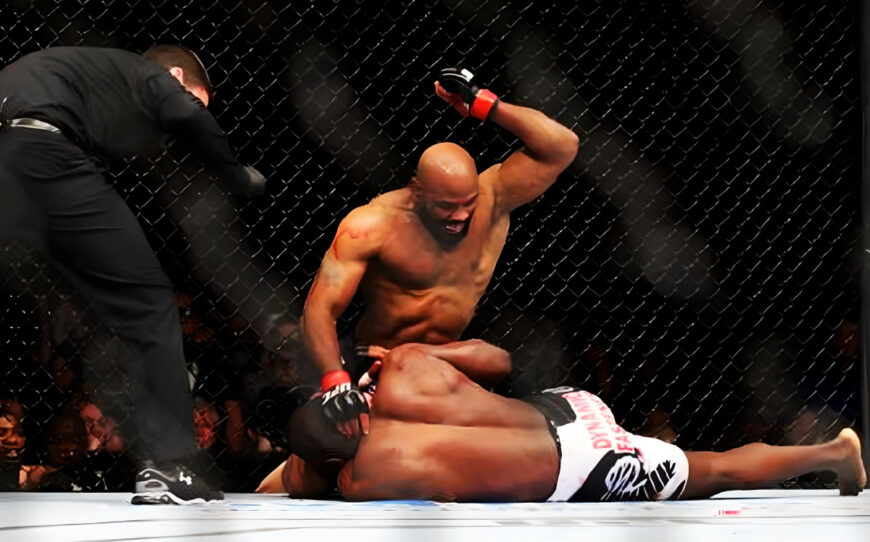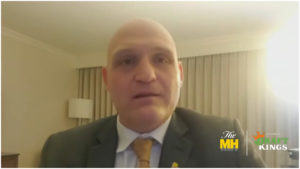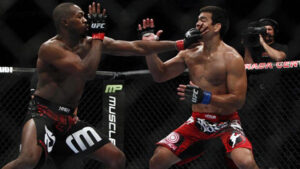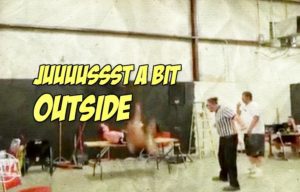In mixed martial arts (MMA), few moves have generated as much debate and controversy as the notorious 12-6 elbow strike.
This devastating technique, characterized by an elbow thrown in a downward trajectory from 12 o’clock to 6 o’clock, has long been banned in professional MMA competition due to concerns over fighter safety and potential injury risks.
Key Takeaways
- The technique can cause significant damage if landed inappropriately, including concussions, skull fractures, or severe cuts requiring stitches.
- Some argue that lifting the ban on this strike could result in more exciting fights, but proponents of maintaining the rules point out that safety concerns must come first in combat sports.
- To reduce risks associated with dangerous techniques such as the 12 – 6 elbow strike, combat sports organizations should try regulating these moves and implementing safety protocols.
Understanding The 12-6 Elbow Strike
Definition And Execution Of The Move In Combat Sports
The 12-6 elbow strike is a powerful and precise technique. It derives its name from the imagery of a clock, as the fighter’s arm moves in a straight line downward, resembling the minute hand moving from 12 to 6.
In combat sports like Muay Thai and MMA, fighters utilize this move when they find an opening in their opponent’s head or upper body region. Usually delivered with full force from a standing position or while grappling, it can cause significant damage if landed.
It requires power generation and accuracy to hit vulnerable targets such as the temple or jawline.
The Risk of Injury Associated With The Technique
The risk of injury associated with the 12-6 elbow strike is a significant concern for fighters and regulators in MMA. The technique can be exceptionally powerful due to the force generated by gravity and its concentrated impact on vulnerable points of the opponent’s body.
Injuries that can potentially result from 12-6 elbow strikes include concussions, skull fractures, or severe cuts requiring stitches – all serious threats.
For instance, ground-and-pound fighters may find themselves at great risk while attempting takedowns or grappling if they accidentally expose themselves to this devastating elbow blow.
Even well-trained defense mechanisms are rendered useless due to limited mobility options available during these encounters.
The Ban On 12-6 Elbows
The ban on the 12-6 elbow strike has been a highly debated topic in combat sports. Some call for its removal and others cite potential injuries as justification for its continued prohibition.
History And Reasoning Behind The Ban
The history and reasoning behind the ban can be traced back to the sport’s early days. It is when officials were searching for ways to establish a standardized set of rules that prioritized fighter safety.
The idea was to eliminate specific techniques perceived as excessively dangerous or brutal, which could lead to severe injuries or even death.
During these discussions, it was determined that the 12-6 elbow posed an inherent risk. It was due to its unique downward trajectory motion.
They opined that this specific strike had a higher likelihood of causing severe harm than other types of strikes, such as standard horizontal elbow or knee strikes.
Furthermore, it provided little room for defense, making it less suitable for inclusion in professional competition.
Despite data suggesting that the risks associated with 12-6 elbows are not necessarily greater than other legal striking techniques, concerns about potential long-term damage – especially around cervical injuries – remain prevalent among critics.
For instance, UFC president Dana White has been vocal about his belief that there is no real difference between various elbow attacks.
However, he continues enforcing current regulations out of respect toward existing legislation within diverse athletic commissions worldwide governing MMA events under their jurisdiction.
Potential Dangers And Injuries Caused By The Strike
The 12-6 elbow strike can result in severe injuries, making it a banned technique in MMA. When executed with full force, the downward trajectory of the elbow strike can cause immense damage to an opponent’s head or neck.
The risks associated with the move include concussions, spinal cord injuries, and paralysis.
Studies have shown that head strikes account for over two-thirds of all knockouts in combat sports like MMA. Elbows are among the most dangerous weapons in a fighter’s arsenal.
Must Read: UFC Illegal Moves: Complete Guide To Banned Techniques In The Octagon
Arguments Against The Ban
Some argue that the ban on the 12-6 elbow strike is unnecessary and limiting to fighters’ strategies, while others suggest modifying the technique to make it safe for competition.
Debate Over The Actual Danger Of The 12-6 Elbow Strike
There has been a long-standing debate in the MMA community about the danger of the 12-6 elbow strike. Some experts and fighters argue that it is not any more dangerous than many other techniques allowed in combat sports. Others believe it poses great risk to be permitted.
One thing that adds to the controversy is that it seems somewhat arbitrary. All elbow strikes are legal in MMA except for this one particular motion.
However, supporters of the ban point out that allowing this strike could result in serious injuries like spinal or neck damage if used improperly or recklessly.
Calls To Overturn The Rule In Certain Combat Sports
Despite the ban on 12-6 elbow strikes in MMA, there have been calls to overturn the rule in certain combat sports. Proponents of lifting the ban argue that the technique is no more dangerous than other legal strikes. Knee strikes and ground and pound are more risky.
However, opponents argue that lifting the ban would pose significant risks to fighter safety. The downward trajectory of the strike can result in severe head injuries and even fatalities if executed with enough force.
The Impact Of The Ban On The Fighters Who Use The Technique
Many argue that it unfairly limits their offensive capabilities and disadvantages them in the ring.
However, others note that safety concerns must come first in combat sports. The risk of injury from this downward-striking technique is high, particularly if it lands on vulnerable areas such as the spine or neck.
Improving The Safety of Combat Sports
Possible Modifications To The 12-6 Elbow Strike
The 12-6 elbow strike has been banned in MMA for many years. However, some advocates have argued that modifications made to the technique can make it safer in combat sports. Here are several possible ways to modify the 12-6 elbow strike:
- Allow the strike to be thrown from a different trajectory: One potential modification is allowing a fighter to throw an elbow strike downward from 11 o’clock to 10 o’clock instead of 12 o’clock. This would still allow for an effective strike while reducing some of the dangers of a straight-downward motion.
- Use protective gear: Another way to make the technique safer would be to require fighters using this move to wear protective gear. Use headgear or thicker gloves. This could reduce the risk of severe injuries.
- Allow it only in certain circumstances: Some have suggested that the 12-6 elbow should remain illegal. However, there may be instances where it’s appropriate – such as self-defense situations outside of regulated competitions.
- Better training and oversight: Another potential solution is better training and oversight for fighters who want to learn and use the move safely and effectively.
Combat sports organizations should continue exploring ways of making martial arts techniques like this one safe while preserving their effectiveness. Balancing fighter safety with skilled combat remains one of these sports’ biggest challenges today.
The Importance Of Fighter Safety In Combat Sports
The safety of athletes is a paramount concern for the industry, governing bodies, and fans alike. Measures are taken to ensure the fights are conducted safely and fairly.
Specifically, the ban on 12-6 elbow strikes in MMA speaks to the importance of fighter safety. These strikes could have devastating impacts on opponents if executed with full force.
Its downward trajectory leaves little room for defense by the recipient, so experts consider it too risky for professional fighting.
FAQs:
What Is A 12-6 Elbow Strike In Martial Arts, And Why Is It Considered Illegal In Some Cases?
12-6 elbow strike refers to a downward motion of the elbow, moving from the twelve o’clock position to the six o’clock position. Combat sports like MMA and UFC use this attack. It can be dangerous since it targets the opponent’s head and can cause serious injury if executed improperly.
Why Do Some Organizations Ban The Use Of 12-6 Elbow Strikes?
Some organizations have banned 12-6 elbow strikes due to concerns over safety for both fighters during matches. These attacks are considered more risky than other techniques. They involve striking an opponent’s skull directly rather than hitting them with softer body parts like fists or open palms.
Are There Any Legal Situations Where A Fighter Could Use A 12-6 Elbow Strike?
Some competitions may allow this type of attack under specific circumstances or rulesets. Still, generally speaking, most martial arts events or professional fighting organizations prohibit its usage altogether for safety reasons.
What Penalties Could I Face If I Accidentally Execute An Illegal 12-6 Elbow Strike During Competition?
You could risk being disqualified from your match or tournament altogether, depending on the severity. Repeated offenses preclude further involvement with certain organizations going forward. There may also be potential fines and legal ramifications involved depending on how severe injuries sustained by your opponent were. Negligence/fraudulent intent played into decision-making surrounding the situation at hand also counts.
Conclusion
The 12-6 elbow strike is a contentious technique that has caused much debate. While it may seem harmless, its downward trajectory can be deadly from that angle.
This is why many organizations and federations, including MMA’s unified rules, have banned it.
While the future of the 12-6 elbow strike remains uncertain, what is clear is that fighter safety should always be paramount in combat sports. Regulators and organizers ensure proper regulations to protect their athletes. This allows for exciting competition within martial arts and other types of fighting styles.









